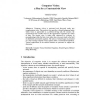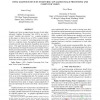14121 search results - page 22 / 2825 » Interval Computations in Computer Vision |
MM
2005
ACM
14 years 1 months ago
2005
ACM
Graphics and vision are approximate inverses of each other: ordinarily Graphics Processing Units (GPUs) are used to convert “numbers into pictures” (i.e. computer graphics). I...
ICMCS
2007
IEEE
14 years 1 months ago
2007
IEEE
The recent emergence of multi-core processors enables a new trend in the usage of computers. Computer vision applications, which require heavy computation and lots of bandwidth, u...
AIME
2009
Springer
14 years 2 months ago
2009
Springer
Computer vision is presented and discussed under two complementary views. The positivist view provides a formal background under which vision is approached as a problem-solving tas...
ICMCS
2008
IEEE
14 years 2 months ago
2008
IEEE
Graphics and vision are approximate inverses of each other: ordinarily Graphics Processing Units (GPUs) are used to convert “numbers into pictures” (i.e. computer graphics). I...
ECCV
1994
Springer
13 years 11 months ago
1994
Springer
A variety of computer vision problems can be optimally posed as Bayesian labeling in which the solution of a problem is dened as the maximum a posteriori (MAP) probability estimate...


